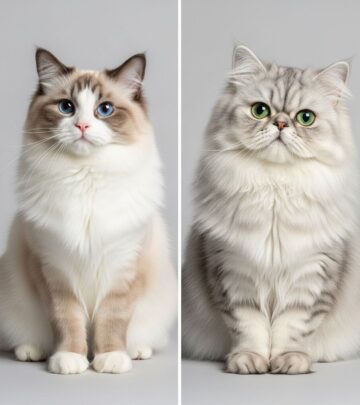Do Cats Have Eyebrows? A Vet-Reviewed Guide to Feline Facial Features
Explore the truth behind cat eyebrows, how feline facial whiskers work, and how cats express themselves.

Do Cats Have Eyebrows?
If you’ve ever seen a cat with drawn-on eyebrows in a meme, you might wonder whether cats have eyebrows of their own. Cats do not have eyebrows like humans; however, they possess specialized hairs and expressive facial muscles that function in ways uniquely suited to feline needs.
The Anatomy of Cat Facial Features
A cat’s face is a remarkable combination of fur, sensitive whiskers, and underlying muscles. Unlike humans, who have a defined line of eyebrow hair above each eye, cats lack this structure. Instead, cats have a series of whiskers above their eyes—known scientifically as superciliary whiskers—in addition to their more prominent muzzle whiskers.
- No Eyebrow Ridge: Cats do not have a continuous strip of eyebrow hair; their faces are fully furred, with no marked ‘eyebrow’ line distinct from the rest of their coat.
- Superciliary Whiskers: The longer, thicker hairs above a cat’s eyes are a unique adaptation, not true eyebrows, but sensitive whiskers that serve vital sensory and protective roles.
- Facial Muscles: Cats use intricate facial muscles to make expressions, sometimes furrowing the area above their eyes, giving the illusion of brows.
What Purpose Do Eyebrows Serve in Humans?
In humans, eyebrows have evolved for two main reasons:
- Communication: Eyebrows enable us to express a wide range of emotions through subtle facial movements.
- Eye Protection: Eyebrows divert sweat, rain, and debris away from our eyes, helping to maintain clear vision and ocular health.
Cats, in contrast, have an abundance of facial fur that naturally protects their eyes. The need for a distinct eyebrow is effectively replaced in felines by their ample fur coverage and sensory whiskers.
Do Whiskers Function as Cat Eyebrows?
Cats have whiskers above their eyes—these are not decorative, but highly functional tactile hairs called vibrissae. These are present in many mammals (excluding humans, platypus, and echidnas). Cat whiskers are found in several key areas:
- Muzzle (Cheeks): The prominent whiskers beside the nose
- Brows: The so-called ‘eyebrow whiskers’ or superciliary whiskers
- Chin: Shorter, yet sensitive, tactile hairs
- Jaw: Often overlooked, but present
- Forelegs: Useful for tactile input during climbing or hunting
The whiskers over a cat’s eyes are not true eyebrows but serve to:
- Protect the Eyes: When triggered by touch or changes in airflow, these whiskers provoke an automatic blink reflex, helping shield delicate eyes from debris, moisture, or foreign objects.
- Sensory Enhancement: Whiskers connect deeply into the cat’s nervous system and are highly sensitive, providing spatial information, especially in low-light environments or while stalking prey.
Table: Human Eyebrows vs. Cat Brow Whiskers
| Human Eyebrows | Cat Brow Whiskers (Superciliary) | |
|---|---|---|
| Structure | Strip of short dense hair above each eye | Rows of long, stiff, highly sensitive hairs above each eye |
| Functions | Facial expression, eye protection | Eye protection, sensory detection, trigger blinking |
| Communication | Express emotions visually | Aid facial expression via underlying muscles |
| Nervous System Role | Minimal | Highly innervated for tactile feedback |
How Do Cats Express Emotions Without Eyebrows?
Cats are masters of expressing their moods without the need for human-style eyebrows. Their communication toolbox includes:
- Facial Muscles: Cats can furrow, contract, or raise the area above their eyes, giving the impression of brows in moments of concern, discomfort, or alertness.
- Ears: Position and movement of a cat’s ears signal excitement, aggression, curiosity, or fear, functioning much like human eyebrows do for communication.
- Eyes: Dilation, narrowing, and blinking patterns provide insight into mood and intention.
- Body Language: Tail, posture, purring, vocalizations, and scent cues add to the mix, making feline communication multimodal and highly nuanced.
For cat owners, reading a cat’s whole face and body is more telling than focusing solely on their ‘brow.’ Look for the combination of flattened ears, narrowed eyes, and furrowed brows as signs of anxiety or unease. An open, relaxed face signals comfort and trust.
The Science Behind Cat Whiskers
Cat whiskers—especially those above the eyes—are not just passive hairs. They are deeply embedded, richly supplied with nerves and blood vessels, and function as some of the most sensitive tactile sensors in the animal kingdom. This makes them highly responsive to:
- Air currents and pressure changes
- Tactile touches from objects or approaching threats
- Triggers for blink reflex and navigational adjustments
Anatomically, each whisker’s follicle is embedded three times deeper than normal fur, and connects to a specialized nerve cluster. Even a subtle vibration produces a cascade of signals interpreted almost instantly by the cat’s brain.
Variation Among Cat Breeds
All cats possess some form of eyebrow whiskers, though visibility varies. In breeds like Ragdolls, Maine Coons, and Norwegian Forest Cats, the brow whiskers are thick and prominent. In contrast, some hairless breeds such as the Sphynx may have noticeably shorter or thinner whiskers—or none at all in rare cases. Yet, even when subtle, these superciliary whiskers remain functional and important.
Common Misconceptions About Cat Eyebrows
- Cat eyebrows are just markings. Many people mistake dark fur patterns over a cat’s eyes as ‘eyebrows,’ but these are pigmentations, not functional hair structures.
- All cats have visible ‘eyebrow’ whiskers. Some owners believe their cat has none, but the whiskers may be short, white, or blend in with the coat, making them harder to spot.
- Whiskers are just for decoration. In fact, they serve essential sensory and protective roles, integral to a cat’s health and daily navigation.
Why Are Eyebrow Whiskers Important for Cats?
Cats’ eyebrow whiskers provide evolutionary advantages:
- Hunting: Whiskers enhance spatial awareness, especially when tracking prey in low light or through dense vegetation.
- Navigation: Detecting openings, obstacles, and air currents aids movement in tight or unfamiliar spaces.
- Eye Safety: The automatic blink reflex triggered by whisker contact protects the eyes from injury or irritants.
- Feeding: As cats have poor focus for nearby objects, whiskers help determine the precise location of food and prey by touch alone.
Do Whiskers Grow Back If Damaged?
Whiskers are living sensory organs. If cut, singed, or broken, they typically will regenerate over time. However, damage to whiskers can temporarily impair a cat’s ability to sense and navigate their environment.
- Do not trim or cut a cat’s whiskers. This causes disorientation, difficulty judging distances, and possible stress.
- Consult your veterinarian if your cat loses whiskers suddenly or excessively, as it may indicate an underlying health issue.
Frequently Asked Questions (FAQs)
Q: Do all cats have eyebrow whiskers?
A: Yes, all cats have some form of whiskers above their eyes, though they may vary in length, color, and visibility depending on breed or individual genetics.
Q: What is the primary function of a cat’s eyebrow whiskers?
A: The main functions are sensory detection (feeling the environment), protection of the eyes via the blink reflex, and enhanced spatial navigation, especially in darkness or while hunting.
Q: Are the short hairs above a cat’s eyes considered eyebrows?
A: No. The short hairs many notice above a cat’s eyes are not true eyebrows but are tactile whiskers (superciliary vibrissae) with unique sensory functions.
Q: Can you tell a cat’s emotions from its ‘eyebrows’?
A: Cats do not raise or lower eyebrows like humans, but their facial muscles and brow fur can shift to show relaxation, alarm, or anger. Paired with ear, eye, and body position, this provides clues to mood.
Q: What should I do if my cat’s whiskers fall out or look broken?
A: Occasional loss is natural, but sudden or widespread whisker loss may signal health issues—consult your veterinarian if you are concerned. Never cut or pluck a cat’s whiskers, as this impairs their sensory abilities.
Key Takeaways
- Cats do not have human-like eyebrows, but possess superciliary whiskers that act as protective and sensory tools.
- Whiskers above the eyes function to protect the eyes and help cats interpret their surroundings.
- Facial expressions in cats are conveyed via a combination of muscle movement, ear tilt, and body language, rather than by eyebrow movement.
- Never trim a cat’s whiskers. Their loss can lead to confusion and distress.
Next time you look at your cat, watch for those subtle brow whiskers and the range of emotions expressed on their furry face. Cats may lack our dramatic human brows, but their faces are marvels of evolutionary design, fine-tuned for communication, hunting, and survival in ways more nuanced than a raised eyebrow could ever convey.
Read full bio of Sneha Tete












